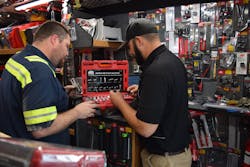
When serving the heavy duty industry, it’s not all about stocking bigger tools to be successful. Chris Nelson, a Mac Tools dealer located in North Sacramento, California, has been visiting heavy duty repair shops for over eight years. He credits his success to taking the time to learn the industry — often by watching technicians work and listening to his customers. In doing so, he knows which tools to stock on his truck — big or small.
Nelson’s clientele mainly consists of Caterpillar, Freightliner, and Kenworth dealerships and independent shops with fleets of all sizes as well as agriculture equipment, school bus, and garbage truck shops.
As many parts, components, and systems widely differ from automotive, learning the heavy duty industry doesn’t just happen overnight.
“You’ll learn fast as you go,” Nelson says. “It’s kind of either a sink or swim, or figure it out — or you look stupid. Just listen to the technicians. A lot of times they like to teach you something.”
When Nelson first began, he would walk through each bay when visiting shops and spark up a conversation with the technicians, asking something as simple as “What are you working on?” This not only helped him learn the industry, but also led to on-the-spot sales. He also found that asking his customers questions was a good way to educate himself on the different tooling geared towards the heavy duty industry. Now he feels well-versed and has customers coming to him, not vice-versa.
Heavy duty-specific tools
Like any industry, having the right tools for the job is essential. For a mobile tool dealer serving or looking to serve the heavy duty industry, it’s important to be aware of the tools needed for general repair work, maintenance, and diagnostics for diesel vehicles and off-highway equipment.
In Nelson’s opinion, selling heavy duty tools is no different than automotive tools, they just tend to be “heavier and bigger.”
“Technicians want the bigger 1/2” and 1/4” guns, bigger 3/4” and 1” drive sockets, bigger pry bars, bigger hammers,” Nelson says. “The big thing now that everyone seems to be moving towards is electric power tools.”
Tools for the heavy duty industry vary from shop to shop, depending upon the service work at hand. However, one thing is certain for all shops: Customers want their equipment up and running sooner rather than later. For commercial fleets, when a truck isn’t on the road, the fleet isn’t making money — any sort of downtime is lost profit. Therefore, being aware of tools that get the vehicles out of the bay faster is crucial.
“One of the most important things for mobile tool dealers to consider when providing sales support to heavy duty and off-highway service facilities is the type of repairs and service work that are most common with these large, heavy vehicles,” says Jeff Marshall, R&D engineer of Schley Products. “Common service and repair work involves the steering gear, suspension bushings, drivetrain components, as well as engine sensors.”
“For this reason, it is important to regularly stock the tools and equipment required to perform these types of repairs and service work,” he added.
Some examples, noted by Marshall, include fuel line tools, specialty wrenches and sockets, and heavy duty pullers and presses designed for removing and replacing larger components equipped on these vehicles.
Additionally, products such as mobile hydraulic presses, specialty pitman arm pullers, and wrenches for removing/replacing sensors are also commonly used within heavy duty repair shops.
“These are types of tools to keep in stock because many times a technician needs them immediately when they encounter that type of service work and don’t have time to special order the tool and wait a few days until it’s delivered,” he says.
Oftentimes, as seen in many diesel and Class 8 vehicles, the bolts where the turbocharger and exhaust gas recirculation (EGR) mount on an exhaust manifold break. This occurs for several reasons, such as corrosion or when the exhaust manifold is removed when a technician needs to repair a blown gasket. However, they mainly break because they go from extreme hot to cold temperatures several times. This heat cycling causes the bolts to lose their elasticity, says Chris Novak, marketing manager at ProMAXX Tool.
When these bolts break off, Novak added, they often get stuck in one of three places: in the turbocharger itself, where the turbocharger mounts to the manifold, or where the EGR mounts to the exhaust manifold. If the bolts get stuck in the exhaust manifold, fleets end up tossing the entire component, no matter the condition it was in.
With ProMAXX’s NINO HD ProKit, fleets can mount the repair kit directly on Mack MP8 and Volvo D13 exhaust manifolds and turbochargers to remove broken bolts. The repair kit not only saves the exhaust manifold and turbocharger from having to be replaced, but also cuts repair time down significantly.
“When bolts break [on Class 8 vehicles], they are often heat-hardened due to the excessive engine heat,” Novak says. “The tooling that normally works for light duty trucks won’t even touch the heavy duty ones because they are so hard. The kits that we made for Class 8 trucks have all carbide tooling to get through the extremely hard bolts.”
When it comes to loosening hydraulic fittings found on tractors, forklifts, and heavy equipment, technicians look for a wrench capable of fitting in small spaces. For scenarios like this, crowfoot wrenches are ideal: they fit onto a nut or bolt’s side thread instead of on top like socket sets do.
Ellery Casey, CEO of Lock Technology, would suggest the company’s 10-pc Heavy Duty Industrial Shockit Crows Foot Set. It uses the force and vibration of an air hammer and can fit into small spaces to reach difficult line nuts with an offset punch.
Lastly, being able to complete a repair directly on the vehicle or a piece of equipment is ideal as it directly impacts repair time. Servicing battery cables is one example. Products such as the Schley Products Battery and Welding Cable Crimper, No. 15600, eliminate the need to remove the entire cable from the vehicle. The 15600 crimps battery terminal ends on vehicles or heavy equipment in any location and on cables up to 0 AWG.
Heavy duty diagnostics
In years past, performing diagnostics on heavy duty diesel vehicles was a lot different than performing diagnostics on cars or light duty trucks due to the number of electronic control units (ECUs). Within the last three to four years, that gap has been closing.
“There are trucks with already 25 to 30 computers on them, which is pretty crazy,” says Bruno Gattamorta, vice president of sales and marketing at Cojali USA. “Everything has become electronically controlled.”
Since more and more data is being passed through the vehicle network, the connector used for diagnostics has also been evolving. The standard connector now for commercial trucks is the (green) SAE J1939 9-pin connector that has a bandwidth capacity of 500 kbps. This is twice the speed as the previous (black) 9-pin connector, which was capped at 250 kbps.
On the other hand, for off-highway vehicles there is no standard diagnostic connector.
“Off-road has about 40 possible connectors,” Gattamorta says. “There is no norm, so every manufacturer pretty much designs whatever cable they deem fit.”
In addition, Dario Peruch, managing director at TEXA USA, explained that there can be multiple diagnostic ports on one vehicle, for example, one for the engine and another for the machine.
When it comes to diagnostic software, ECUs on heavy duty vehicles require more adjustments, or resets and calibrations. Some adjustments, Peruch noted, include diesel particulate filter (DPF) regeneration, idle shutdown, power takeoffs (PTO) resets, gear self-adaptations, and ABS resets.
For mobile tool dealers, it’s important to be aware of the diagnostic software available in addition to the hardware required and the diagnostic tools themselves.
“There’s a scan tool for every budget, but generally speaking heavy duty and off-highway technicians prefer to spend more for a tool that offers more and has several functions compared to something basic and limited,” Peruch noted. “An option that offers coverage on different vehicles is definitely preferrable.”
TEXA USA offers a diagnostic tablet, the AXONE NEMO, which is designed to work on every vehicle, Peruch says. Technicians can purchase various packages, depending on the coverage needed. Peruch recommended that mobile tool dealers start with the TEXA AXONE Truck package, which allows technicians to add individual licenses to cover different vehicles.
Additionally, TEXA’s software shows the technician which adapter is needed and, for most selections, provides a short video showing where the socket is and how to connect the adapter.
Cojali offers a similar concept. Their diagnostic tool, Jaltest Link, is suited for all makes and all models, and performs diagnostics, bidirectional controls, and guided troubleshooting within one unit.
Users can simply add off-highway, agricultural, commercial, or marine coverage to gain access to various brands and vehicle types.
It should be noted that cables can be exclusive to the category or can be shared, depending on the manufacturers, Gattamorta noted.
Keep fully stocked with heavy duty tools
Like the automotive industry, heavy duty shops often find themselves in need of a specific tool at any given time. By having the tool stocked and being just a call away is a win-win for both parties.
“You need to keep a well-stocked truck,” Mac Tools dealer Nelson says. “When customers need a tool, they can’t wait or don’t want to wait. You are more apt to make the sale if you have the items in stock rather than to order it. On some of the bigger ticket items if a shop calls in desperate need of a tool, they are more likely to buy it if you have it right then. If not, they may go elsewhere to get it.”
And although stocking your truck for the heavy duty industry may seem overwhelming at first, be reassured that your best resource is always a conversation away — your customers. For Nelson, this back-and-forth conversation is key because being a pushy salesman isn’t his gig — he’s an honest guy who’s seen more as a friend than a guy selling tools.
“I hate salesmen,” Nelson says. “I don’t want to be a salesman. I’m more like everyone’s buddy. I don’t think my sales technique is better than anybody else’s, but people tend to like me.”
When it comes to making the sale, Nelson says the best thing a mobile tool dealer can do is listen.
“Listen to what they are asking for and listen to what they are working on,” he says. “It leads into making a sale that way. [Not to mention,] if you’re not listening, they will lose interest real quick.”
About the Author
Kayla Nadler
Associate Editor | Vehicle Repair Group
Kayla (Oschmann) Nadler was previously an associate editor for the Vehicle Repair Group.
With an education in journalism and public relations, Nadler contributed to Professional Tool & Equipment News (PTEN) and Professional Distributor magazines, as well as VehicleServicePros.com.
